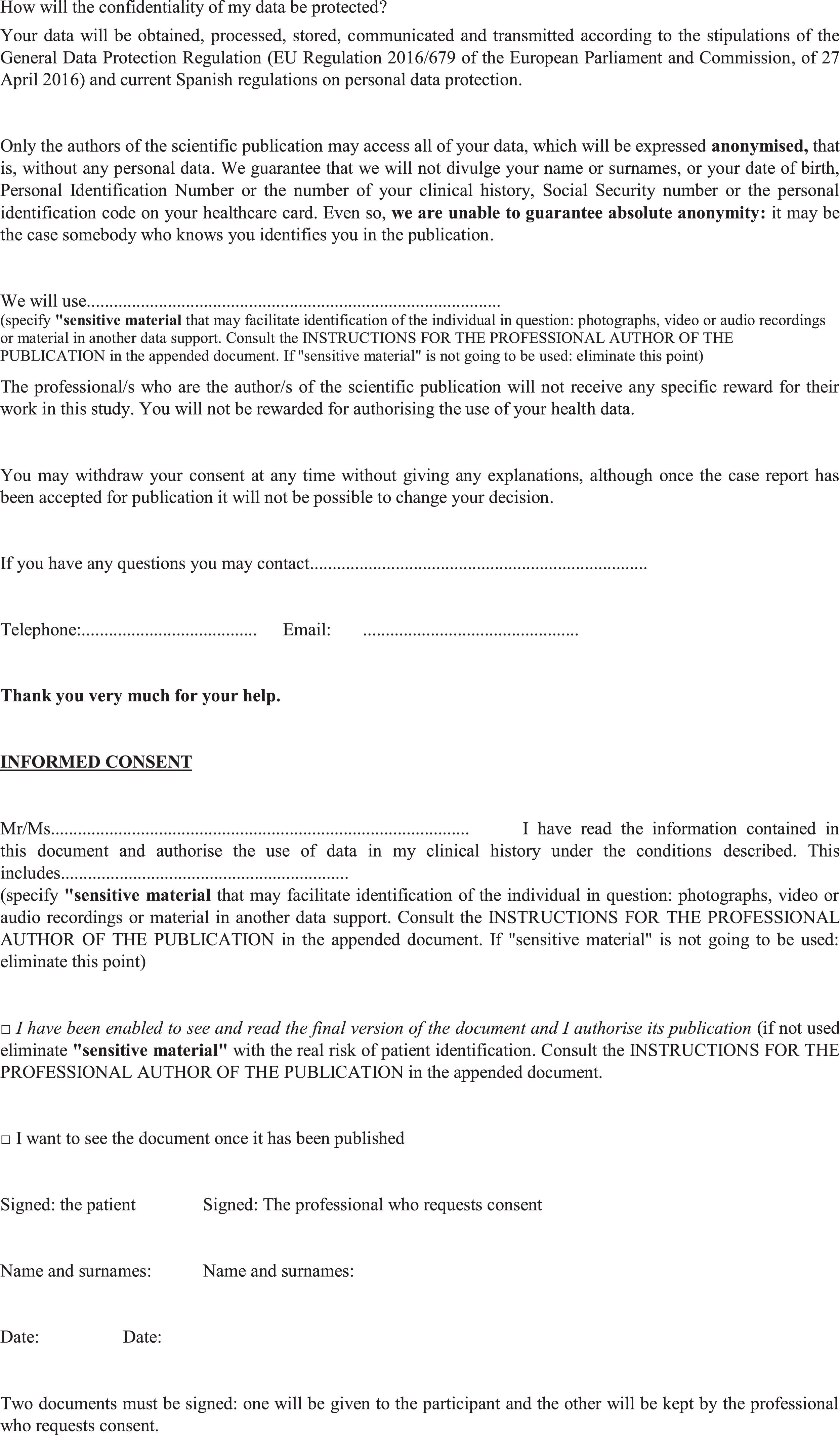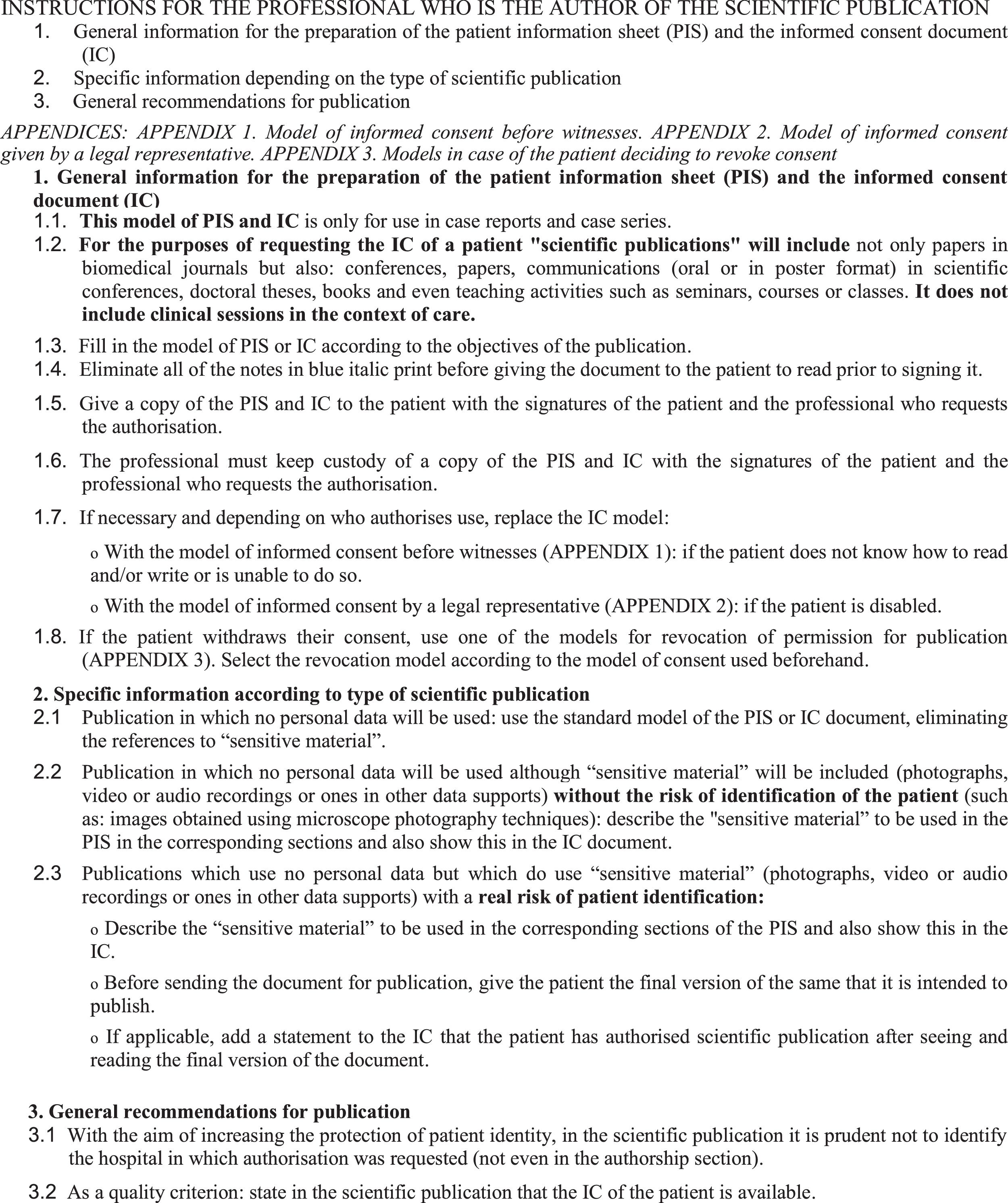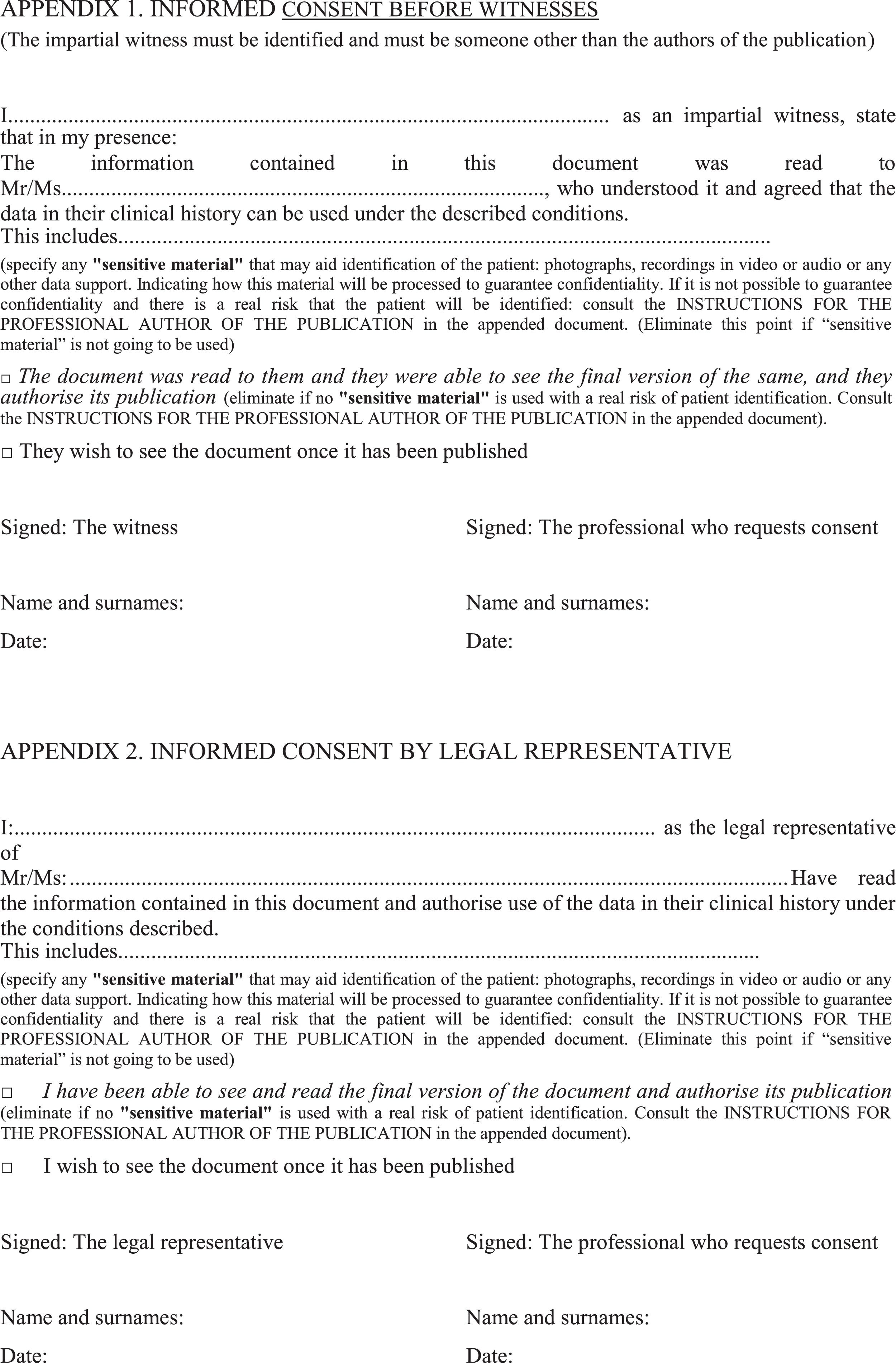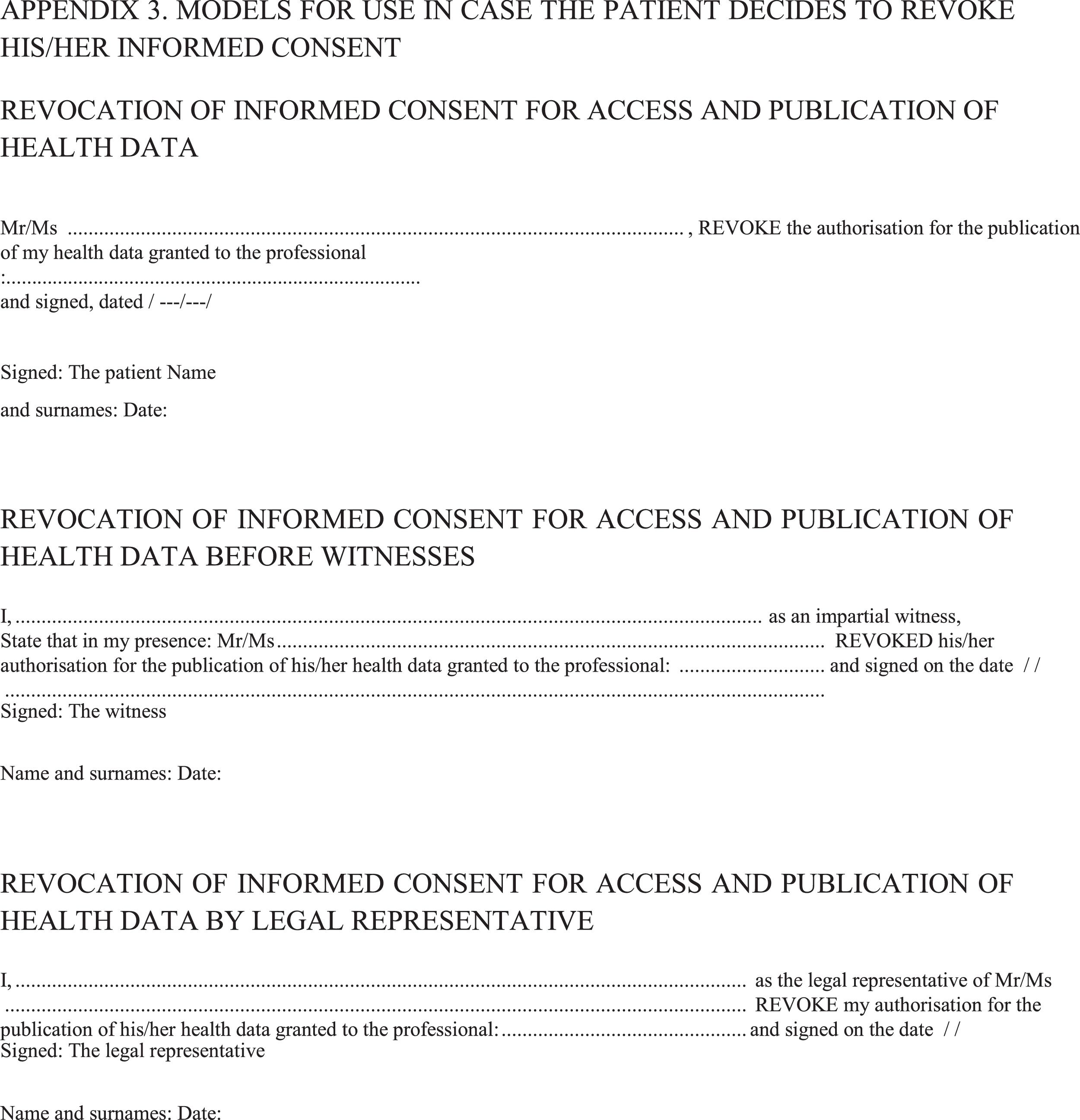A standard model of the Patient Information Sheet (PIS) and Informed Consent (IC) would facilitate compliance with the guaranteed rights of the patient when their health data is used in any form for purposes other than medical assistance, like the release of case reports and case series. This model would be suitable for the presentation of case reports in a congress in any form (verbal communication, poster or presentation), for its publication in a journal that does not require the completion of its own model, or even for teaching practice.
A standard model of the PIS and IC would facilitate the application of the current regulations and good clinical practices in clinical research: it would guarantee the compliance of the professionals’ duty of protection of the patient's privacy against the use of their health data for purposes other than medical assistance.
Un modelo estandarizado de Hoja de información al paciente (HIP) y Consentimiento informado (CI) facilitaría el cumplimiento de garantizar el derecho de los pacientes cuando se utilicen sus datos de salud en cualquier soporte con fines distintos al asistencial, como es la divulgación de casos clínicos y series de casos. Este modelo sería adecuado, para la presentación de casos clínicos en un Congreso en cualquier formato (comunicación oral, póster o ponencia), para su publicación en una revista que no exija la cumplimentación de un modelo propio o incluso para una actividad docente.
Un modelo estandarizado de HIP y CI facilita la aplicación de la normativa actual y de las Normas de Buena Práctica en Investigación Clínica: garantiza el cumplimiento del deber de los profesionales de proteger la intimidad de los pacientes ante el uso de sus datos de salud para fines distintos a la práctica asistencial.
Case reports and case series are descriptive observational studies. Although there is no agreement on the number of patients to be included in the definitions of both types, it is generally accepted that case reports describe selected observed characteristics of a single patient, while case series describe a group of patients with a certain condition in common.1,2 Nevertheless, the scientific literature does not clearly differentiate between these definitions. For example, in PubMed both types of study are included under the single descriptor (or MeSH term) of “case reports”, regardless of the number of patients observed (one or more than one).3 One clearly established characteristic is that both types of study have no control group.
According to Oxford University, evidence-based principles of medicine place case series lower down in terms of level of scientific evidence than randomised clinical trials, systematic reviews or cohort studies. Case reports were excluded from its 2011 update.4
However, case reports have always been used in teaching5 and they reflect contemporary medical and surgical practice. They show the decision-making process simply and didactically in patients with a specific and usually singular set of symptoms.6 Case reports and case series often document the emergence of new diseases or adverse reactions to medication. In spite of their major limitations (as the lack of a control groups makes it impossible to evaluate a cause–effect relationship or to test a research hypothesis1,7), case reports and case series are a useful means of epidemiological vigilance and formulating causal relationships.2,3,8,9 Case series are sometimes the only possible design (for example, to complete data on the long-term safety aspects of drugs).10
Evidence-based medicine uses randomised and controlled clinical trials (as well as meta-analysis and systematic reviews of them).10 However, case reports and case series still form a part of medical knowledge, as is shown by the fact that more than 1,700,000 case reports and case series have now been registered in PubMed since the first publication of a case series in 1936.11 This massive number of publications (a million more are recorded in PubMed than is the case for clinical trials) would have to be added to the majority of communications in scientific conferences that are not published in journals. These are known as “grey literature”, and they often have this type of descriptive study design.
Little attention has been paid to patients’ right to privacy in scientific publications of case reports and case series, including communications in Conferences or scientific journals. Based on anecdotal clinical observations rather than a prior hypothesis, works of this type are not designed using research project methodology and they are therefore not subject to approval by a Research Ethics Committee (REC). Thus when these studies are presented in Conferences or published in scientific journals, the researchers and even the editorial committees of journals generally ignore ethical-legal aspects. This is a striking fact, as given the small number of patients included in cases reports and series, together with the fact that they describe infrequent, exceptional or unexpected situations, it is far easier to identify the patients involved than it is for those in other types of study with larger samples.5
Legal basisIn the field of healthcare the right to privacy is divided into two differentiated rights12: (1) the right to privacy and (2) the right to data protection.
The right to privacy: privacy is a fundamental right that is one of the list of rights covered by the Spanish Constitution (SC) of 1978 (art. 18.1) and it derives from the right to respect for private and family life recognised in the 1948 Universal Declaration of Human Rights. The consideration that privacy is a “human right” gives it a special meaning, a value that is special or extra in comparison with other rights. The right to privacy includes the right to confidentiality and is comparable with “professional secrecy” (“confidentiality” is a better expression than “medical professional secrecy”, as it is conceptually broader). It is understood to be an obligation that binds professionals when working in an area that includes personal privacy. On the other hand, professional secrecy stems from the self-regulation imposed by the profession (professional ethics), while confidentiality is a right held by patients. From a bioethical viewpoint based on classical principles, the respect for privacy, as well as being based on respect for the principle of independence, is also a part of the obligation of healthcare professionals not to do harm.12,13
The right to data protection: the protection of individuals in connection with how their personal data are managed is a fundamental right in law: all individuals have the right to protection of their personal data (art. 18.4 CE).14–16
At a European level, in May 2016 the European Data Protection Regulation17 (EDPR) was published. This covers the protection of individuals respecting the management of their personal data and the free circulation of such data, replacing the Directive that had been in force.18 This European Regulation, which became applicable in Spain on 25 May 2018, unifies and modernises European regulations on data protection, offering citizens better control of their personal data.
The following laws stand out among the applicable national laws governing the use of health data in observational research: the Spanish data protection law (LOPD),19 the Royal Decree that expresses this20 and the Law of Patient Autonomy (LBAP).21 Until 25 May 2018, Spain and the other member states were able to adopt or initiate the preparation of specific regulations that may have been necessary to permit or facilitate the application of the EDPR. After 25 May 2018 the EDPR is obligatory in all of its elements, and it is directly applicable in each member state.
According to the EDPR, health and, as a novelty, biometric data,1 are considered to be “special categories of personal data”, and use of them is expressly prohibited unless this is necessary for care purposes or if some circumstance of general interest is present, or if the individual involved expressly consents to the same (article 9.2).
The EDPR introduces the “pseudonymisation”2 of personal data as a means of reducing the risks to the patients involved and helping researchers to fulfil their obligations, without aiming to exclude any other data protection measure. Nevertheless, pseudonymisation (or coding or reversibly disassociating data, which are the same thing), and which in certain types of research studies and/or specific circumstances, and always after a previous finding in favour by a REC, allows us to use patient health data without their consent, is not applicable to the publication of a case report, as in this the researcher is fully aware of the identity of the patient.
Patient consent is one of the fundamental bases for working with personal data, and in our case with health data. The EDPR requires consent to be generally free, informed, specific and clear. For consent to be considered clear, the EDPR requires that the parties involved make a declaration or a positive action that expresses their agreement. Consent cannot be deduced from patient silence or inactivity.
Additionally, the EDPR states that consent has to be explicit in special categories of personal data (such as the management of health data). This is an even stricter requisite, as consent cannot be understood to be implicitly granted by some type of positive action. It is therefore necessary for a declaration or action to explicitly refer to consent and the specific action (such as the publication of a case report).
It has to be taken into account that consent must be verifiable and that the individual in charge of data processing, the chief researcher, who is usually the first signatory of the paper, must be able to prove that the patient “consented to the use of their health data”.
Model of the proposed patient information and informed consent documentThe model of the patient information (PI) and informed consent document (IC) that we propose is standardised and specific for use in case reports and case series. It fulfils the recommendations of the Committee on Publications Ethics (COPE) and has been approved by the Territorial REC of A Corunna-Ferrol, which belongs to the REC network of the Autonomous Community of Galicia (Appendix A). This model is for the use of observational type health research data that does not use human biological samples or tissues (expressly excluded from the field of application of the Biomedical Research Law).23 Its design takes into account measures to facilitate the participation of individuals who are sufficiently personally independent to consent and who have some type of disability that prevents them from reading or writing, according to the rights of individuals with a disability.24 It also includes the possibility of revoking consent. Due to its special importance we underline the identification of the type of information supplied in the case of clinical reports (use or otherwise of sensitive material – photographs or videos – and, if this is so, the actual risk of identifying the patient). The higher the risk of patient identification, the more they have to become involved, even allowing them to read the final version of the document before granting their consent. The model is accompanied by instructions for the researcher so that it can be completed correctly, and the definition of “scientific publication” is included in the request for IC, together with general recommendations for publication (Appendix B). It can be downloaded in Galician or Spanish from the web page of the Network of RECs of the Autonomous Community of Galicia (https://acis.sergas.es) or from the web page of the Repositorio Institucional de la Consellería de Sanidad-Sergas-RUNA (https://runa.sergas.es)‡.
‡ To download the document from the web page of the Network of RECs of the Autonomous Community of Galicia (https://acis.sergas.es): select the desired language of the model (in the top right corner: Spanish or Galician) and then click on the following sections: Investigación→Red de comités de ética de la investigación→5. Modelos de documentos→8. Modelo de consentimiento de publicación de caso clínico. To download the document from the RUNA web page (https://runa.sergas.es): write “consentimiento informado de casos clínicos” in the general search engine. Another option giving direct access to the document is using the abbreviated URL: https://bit.ly/2kR7wOt.
DiscussionHistorically case reports have been published without the consent of the patient. However, regulations have evolved in legal and ethical terms, so that consent is now obligatory.25
From a legal as well as an ethical point of view precautions have to be taken to prevent the description of a case report from making it possible to identify the patient (the right to privacy and confidentiality). It is also necessary to obtain their informed consent or that of their family prior to publication (the principle of independence). Even when there are no reasonable possibilities of identifying the patient in a case report, patients must always decide on the use of their health data.25 Obtaining their informed consent will also give the researcher due protection again any possible claim or lawsuit by the patient due to the publication of their health data.
The “International Committee of Medical Journal Editors” recommends that the informed consent of patients be demanded prior to publication, although it does not expressly mention case reports.25,26 This item of diligence should also be included in published papers26 and therefore also in scientific communications.
Ideally and to facilitate the above step for researchers, there should be a universal model of PI and IC for these descriptive studies that could be supplied (duly adapted by the researcher) to patients prior to sending papers to Conferences or scientific journals. There is already demand in the scientific community for a universal model of IC for the publication of case reports (currently, if a journal uses one model of IC it will not accept the model used by another journal, so that patients have to be asked to sign several models consecutively when one journal rejects a manuscript and it is sent to others, until it is published).27,28 Although it does not at the present time support a universal model, the COPE, which is currently composed of approximately 10,000 peer reviewed scientific journal editors, does set out a series of recommendations for minimum informed consent. This has to be included in the IC for case reports.22
We believe that a standardised model of PI and IC would aid compliance with the guarantee of patient rights when their health data are used in any support (computerised, paper, audio or images), for purposes other than treatment. This would apply to case reports and series of cases. For example, this model would be suitable for the presentation of case reports in a Conference in any format (oral, poster or paper), for publication in a journal that did not demand the use of a specific model, or even in teaching.
Since we presented this proposal in a Conference of family doctors in 201529 we have observed increasing awareness in the healthcare sector, while increasing numbers of journal editors30 demand that authors supply the informed consent of patients as an indispensible requisite for the publication of case reports. This attitude contrasts with the current situation in the majority of Scientific Societies in our country, whose Organising and Scientific Conference Committees, in their norms for the acceptance of case reports, either do not mention obtaining informed consent or state that it is a “favourable aspect”, without demanding it. We encourage the editors of all of the scientific journals which do not have their own model of informed consent for case reports and case series to use our standard model. We also encourage Scientific Societies to adopt the proposal, informing their Organising and Scientific Committees for Conferences, Meetings and other events of this priority.
ConclusionsHealthcare professionals have to include patient rights in their research.
The standardised model of PI and IC facilitates the application of the current regulations and Norms of Good Clinical Research Practice: it guarantees compliance with the duty of professionals to protect the privacy of patients when their health data are used for purposes other than treatment.
As well as supporting patient independence, gaining their IC also protects researchers against any claim by the individual whose health data are used. It is also a quality criterion for the publication of case reports and case series (including the presentation of communications in Conferences or Scientific Symposiums). The “International Committee of Medical Journal Editors” and the “Committee of Publications Ethics” recommend that authors be obliged to supply this document prior to publication.
The cultural change we suggest seems to be easy to achieve, given that the low number of patients included in case reports and case series makes it easy for researchers to obtain their consent before publication.
It would be desirable to include the standardised model of PI and IC in patient electronic clinical histories.
Source of financingNone.
Conflict of interestsThe authors have no conflict of interests to declare.
We would affectionately like to thank our companions in the A Corunna-Ferrol Territorial Research Ethics Committee, together with Paula López Vázquez and Rosendo Bugarín González (Technical Secretary and member of the Galician Autonomous Region Research Ethics Committee, respectively) for their constant encouragement and support in this project and always.
Personal data obtained from a specific technical process relating to the physical, physiological or behavioural characteristics of an individual that permit or confirm the unique identification of the said person, such as facial images or fingerprint data.
Please cite this article as: Cruz del Río Río J, Sastre Gervás I, Romero Yuste S. Hoja de información al paciente y consentimiento informado de casos clínicos y series de casos: propuesta de un modelo estandarizado para comunicaciones en congresos y otras publicaciones científicas. Reumatol Clin. 2018. https://doi.org/10.1016/j.reuma.2018.07.001
Processing personal data in such a way that it cannot be attributed to an interested party without using additional information, on condition that the said additional information is supplied separately and is subject to technical and organisational measures with the aim of guaranteeing that personal data are not attributed to an identified or identifiable individual.













